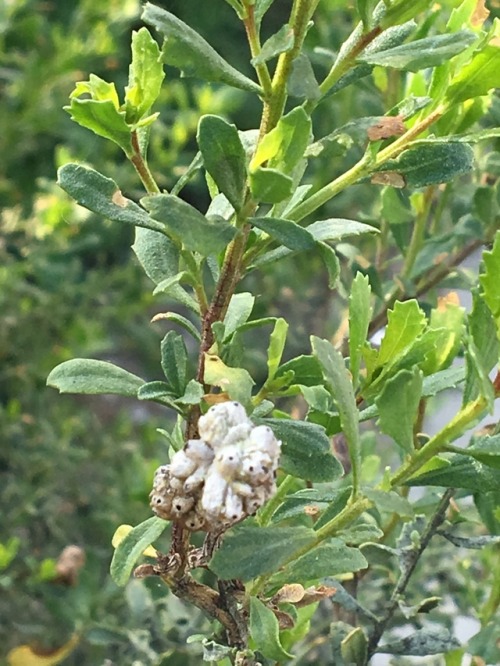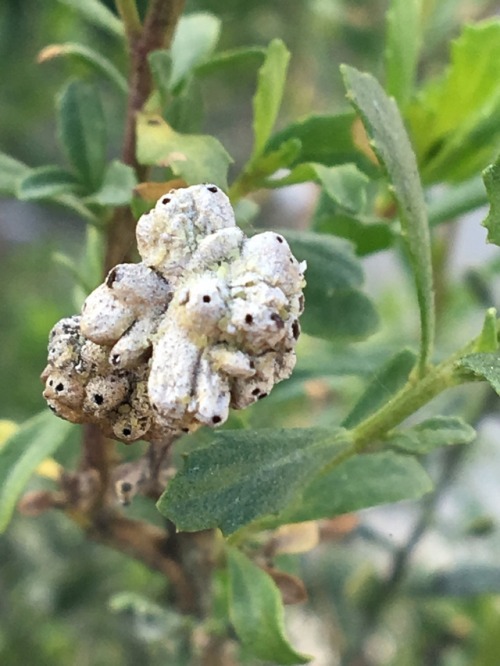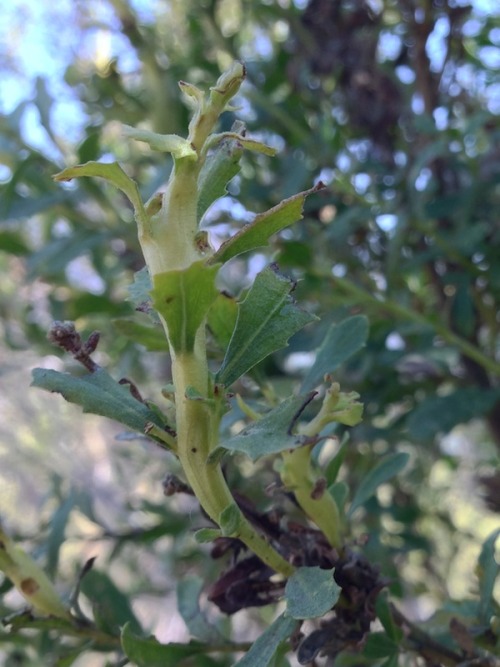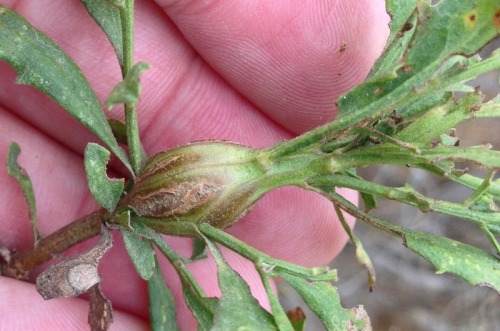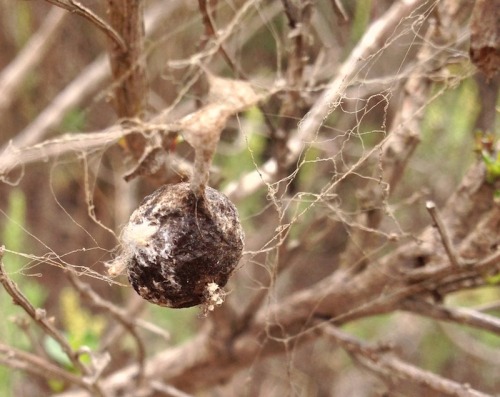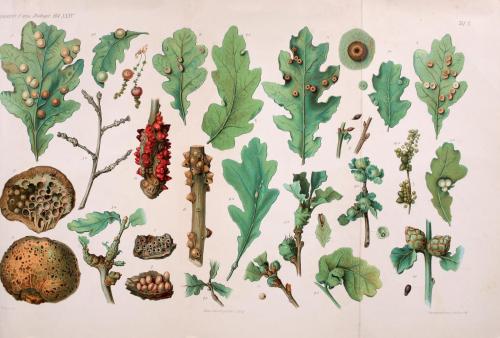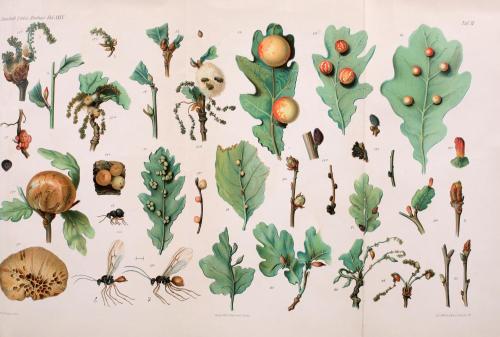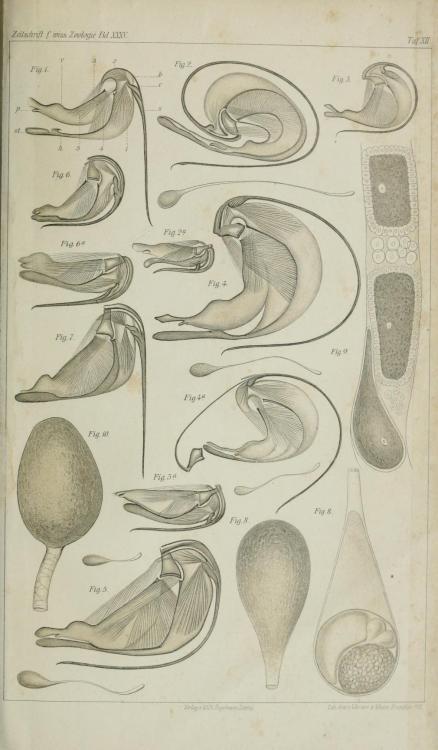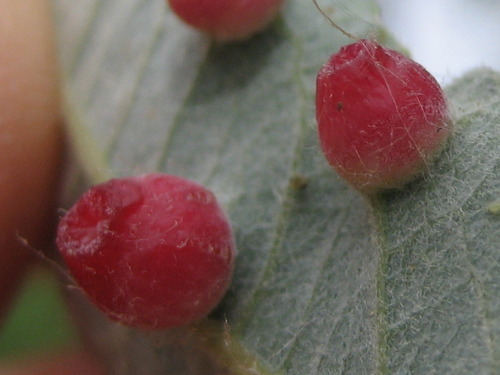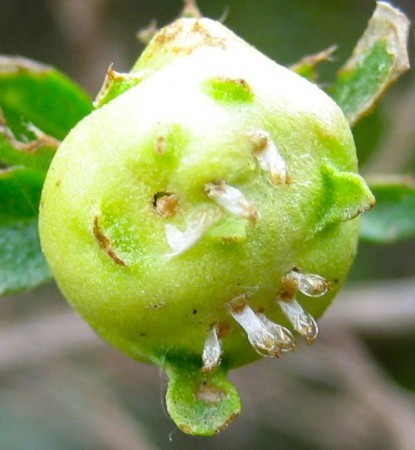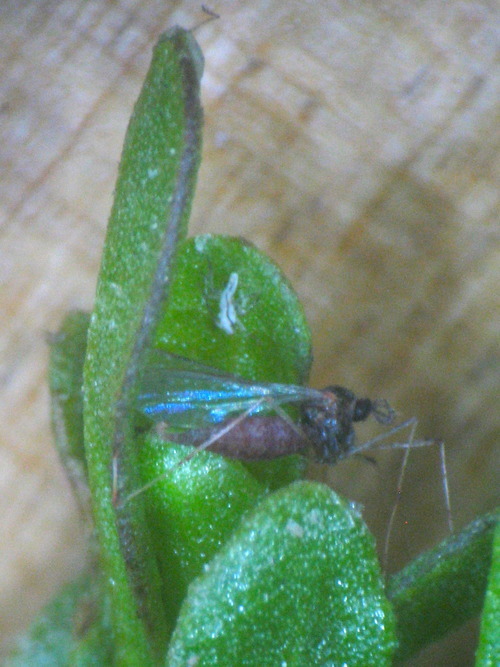





Baccharis pilularis galls at Solstice Canyon, Malibu
I mentioned before that one of the things I enjoyed about Yulin’s beautiful I Didn’t Write This Ep. 2 (the one with Auden’s “As I Walked Out One Evening”) was the setting. They shot the video in Malibu’s Solstice Canyon, which I’d never visited before. It looked like there was some coyote brush (Baccharis pilularis) in some of the shots, but I wasn’t sure, and since yesterday was my once-every-two-weeks mega-commute via Malibu, I decided to check it out on my way to work.
I really loved it. There’s water in the stream year-round, and the riparian habitat along the main trail was super birdyish. I didn’t have my binoculars with me (which was just as well, or I probably would have been late to work), but the southern California nesting season is getting under way, so there was lots of singing. Yellow-rumped warblers, oak titmouses, California towhees, spotted towhees, and white-crowned sparrows were everywhere.
The upper slopes (which I didn’t have time to hike to) looked too xeric for coyote brush, but down near the creek there was a fair amount of it. It was more spindly than the plants I’m used to near Santa Barbara, and the seed heads on the female plants seemed a little less profuse; I suspect that’s because Malibu is warmer and dryer than where I live. There also was less coyote brush overall in the habitat; individual plants were scattered around, rather than occurring in extensive stands.
When I’m around coyote brush I always look for galls. There were relatively few Rhopalomyia californica galls compared to what I’m used to, but I found some that you can see in the middle row of photos above.
You’ll probably think I’m an idiot to feel this way, but I get choked up when I think about the midges that induce those galls. They spend most of their lives as tiny maggots inside the gall, feeding on plant tissue. Then they chew their way to the surface and pupate, their body liquifying before transforming into an adult midge, and then finally, on a particular cool morning, often a day or so after a rain, a bunch of them emerge together.
The females’ abdomens are already orange and swollen with eggs. The males mate with them and die; the females lay their eggs before dying a few hours later.
They live their whole lives for that one day. I’ve never seen a Rhopalomyia emergence in-progress, though I keep looking. Once I found a dead female a day or two after emergence, a sticky trail of eggs connecting her to the plant, dead in the very act of laying her eggs. Will my own life have a dramatic climax like that? Probably not. I’ll just get older and crankier, and eventually something will take me out. But that Rhopalomyia midge died a heroine, fulfilling the point of her existence in her final moments.
Besides the R. californica bud galls, I also found a couple of stem galls made by a moth, Gnomorischema baccharisella. You can see them in the bottom row of photos. A cool thing about these galls is how different the ecology of the gall itself is, compared with the similarly sized R. californica galls that grow on the same plant. The Rhopalomyia bud galls contain multiple larvae, but a G. baccharisella stem gall contains only a single caterpillar. The larvae in the bud galls don’t produce frass (insect poop). I’m not sure what happens to their waste; either they don’t emit any, or it somehow is excreted and carried away by the plant. That latter explanation seems kind of unlikely, but I don’t actually know much about insect/gall interactions, and over evolutionary time scales gall inducers and their host plants have evolved pretty complex relationships.
The caterpillar in the stem gall does produce frass, which accumulates inside the gall. When the caterpillar gets old enough it chews its way out and drops to the ground to complete its development. But now there is a convenient hole in the gall (you can see it in each of the galls pictured above, meaning both of those galls have already lost their original caterpillar), and a bunch of other organisms move in. Colonies of fungi grow on the frass, and fungus mites that eat the fungi, and other creatures that prey on or parasitize the mites. There are whole little worlds in there, and that’s just one type of gall on one type of plant.
When I give in to the temptation to talk about plant galls during docent tours at the marsh, someone usually asks about the nature of the relationship. Are the gall inducers harming the plant? Helping it? And what they’re really asking is, are these good bugs or bad bugs?
It’s a good question. Looking strictly from the perspective of the plant, the gall inducers are harmful. In parts of Australia, where groundsel bush (a close relative of coyote brush) is an invasive weed, R. californica has been imported as a biological control, because the bud galls take the place of flowers, reducing the plant’s reproductive success. In effect, R. californica harnesses the plant’s activity and channels it into producing more R. californica midges, rather than producing more coyote brush.
But the plant’s perspective isn’t the only one. From the point of view of the larger ecosystem, gall inducers are just doing what nearly every other organism has done before it: Finding a niche in the pre-existing biome within which it can survive, adding one more layer to the mind-bogglingly rich assembly of interrelated living things that make up all life.
From that perspective, what gall inducers do is awesome and cool. Certainly the fungus mites that specialize in living inside old G. baccharisella galls would say so, if you could ask them, as would the dozen or more species of parasitic wasps that prey on R. californica, or the hyperparasites that prey on those parasites, or the specialized bacteria that live in the guts of those hyperparasites, and so on, as far as human curiosity can take you. The more I learn about this, the more I believe that people like James Lovelock and the late Lynn Margulis were on the right track in arguing that we spend too much of our time focused on the organism as the most meaningful level of biological organization. We also need to think about life as a whole.
One other thing I liked about Solstice Canyon: Its parking lot was nearly full, but it’s a small lot, and the people who were there were really nice. I think the fact that it’s kind of hidden away on a side road means you’re only going to get people who make a point of seeking it out, and that selects for a certain kind of visitor.
At one point I was standing under a big sycamore, trying to see a woodpecker that I could hear drumming. Two people, an older woman and a younger woman who might have been her adult daughter, were standing not far away. I didn’t notice them paying any attention to me, but when I walked past them the younger woman asked me if I’d been looking for the bird.
“What?” I said, not because I hadn’t heard what she said, but because I’m shy, and a dork, and I’d been shocked out of my big-city bubble by a stranger willing to talk to me.
“Were you looking for the bird?”
“Oh, the woodpecker? Yeah. I couldn’t see it, though.”
“I’ll show you,” she said, and walked back a few feet to point out the bird, an acorn woodpecker that was hammering away at the underside of a dead limb.
“Thanks,” I said, and smiled, and she smiled, and we went our separate ways. And maybe it was just me being maudlin from thinking about Yulin’s video, which made me cry when I watched it — because of the music, and the images, and Auden’s words, and Sean’s delivery — but it just seemed like a really nice thing of that woman to do, noticing that I’d been looking for the bird, and helping me see it.
tl;dr: I had a really nice time at Solstice Canyon, and I’m happy I followed Yulin’s recommendation to visit it.
Reposted from http://ift.tt/1j1wXEC.

